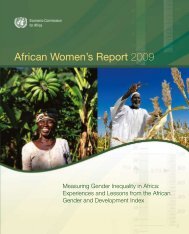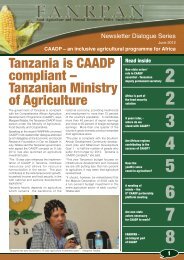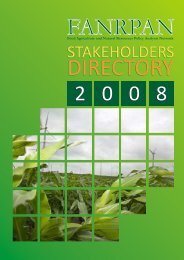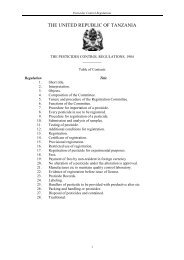Community-driven development decision tools for rural - IFAD
Community-driven development decision tools for rural - IFAD
Community-driven development decision tools for rural - IFAD
- No tags were found...
Create successful ePaper yourself
Turn your PDF publications into a flip-book with our unique Google optimized e-Paper software.
the CBOs (i.e. VDCs and different types of CIGs). Preferably, these roles should be clarified fromthe beginning of project design. Postponing <strong>decision</strong>s to after the project has been approvedoften leads to unpleasant surprises (i.e. activities cannot be undertaken, or can be done only byagents who have motivations different than achieving the CDD project objectives).The nature of the partnership that a CDD project may establish with the districtadministration depends on the extent to which the policy and approach of the project is sharedby the district authorities. <strong>IFAD</strong>’s key objective <strong>for</strong> the partnership would be to improve theinteraction between the district administration and the CBOs. This requires that the CBOs andthe district administration share views about four main subjects (see Box 28).Experience shows that an intermediary organization between the community and the districtlevel is essential to enable the community’s voice to reach the district level 31 and can help makedistrict plans more advantageous <strong>for</strong> the communities. If the subdistrict level of the publicadministration is allowed to bridge gaps between the CBOs, the District Assemblies and thedistrict administration, the partnership between the project and the district administration willbe closer. However, its impact can be diluted in the absence of institutional mechanisms thatstrengthen the role of the subdistrict level, which are seldom in place.Integrating the CBOsCBOs are the most important partners in a CDD project. A central <strong>decision</strong> in designing projectsis how to integrate the CBOs, directly and through their apex organizations, in projectimplementation. This can be done through the subdistrict and district levels of the localgovernment or through independent, complementary CSOs.When a new project begins, an apex organization of active CBOs rarely exists (except in“repeater projects areas”). As a result, most of CDD’s key partners must be created. This is indeeda crucial issue that raises a number of key questions, such as• How genuine are the CBOs and their apices that were created <strong>for</strong> a project?• How committed are their members?• What are their motivations <strong>for</strong> getting together?• How sustainable are they?• Who controls them and what is the controllers’ true purpose?Box 28Improving interaction between districtadministrations and CBOsInteractions between district administratorsand CBOs can be improved if they shareviews on these four topics• which activities the CBOs have autonomousauthority to plan and implement withpublic support;• which community-planned activities mustbe reported to the district authorities only<strong>for</strong> in<strong>for</strong>mation purposes and whichactivities must be approved at thedistrict level and with which instrumentsof approval;• the mechanisms <strong>for</strong> financing communitylevelactivities (i.e. whether they should befinanced through the district budget orthrough a separate channel);• tasks that may be entrusted to the districtadministration (e.g. technical assistanceservices, control of security andenvironmental standards and per<strong>for</strong>mancemonitoring of the organizations receivingpublic finance).31 The view is confirmed by the experience of the Ghana Village Infrastructure Project (VIP), jointly financed by <strong>IFAD</strong>, the World Bankand KfW, which undertook a fairly largescale pilot project to activate the Area Councils (the administrative unit below the Districtin Ghana’s decentralized administration) and mobilize about ten villages. This experiment was quite successful in increasing thenumber of community-level projects which were brought to the attention of the Districts which had in place a system <strong>for</strong> theselection and financing of social infrastructure projects in their areas of competence.59
















